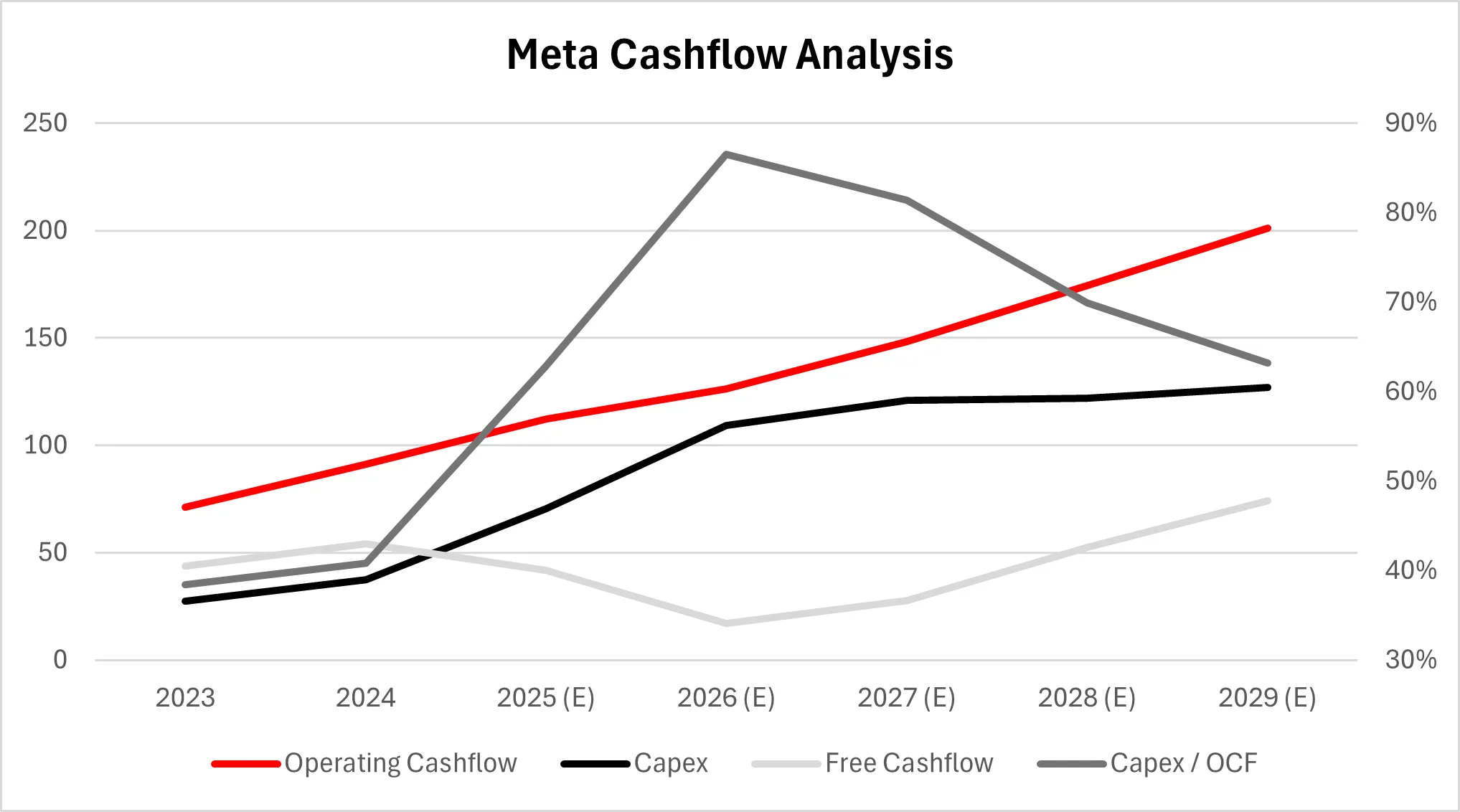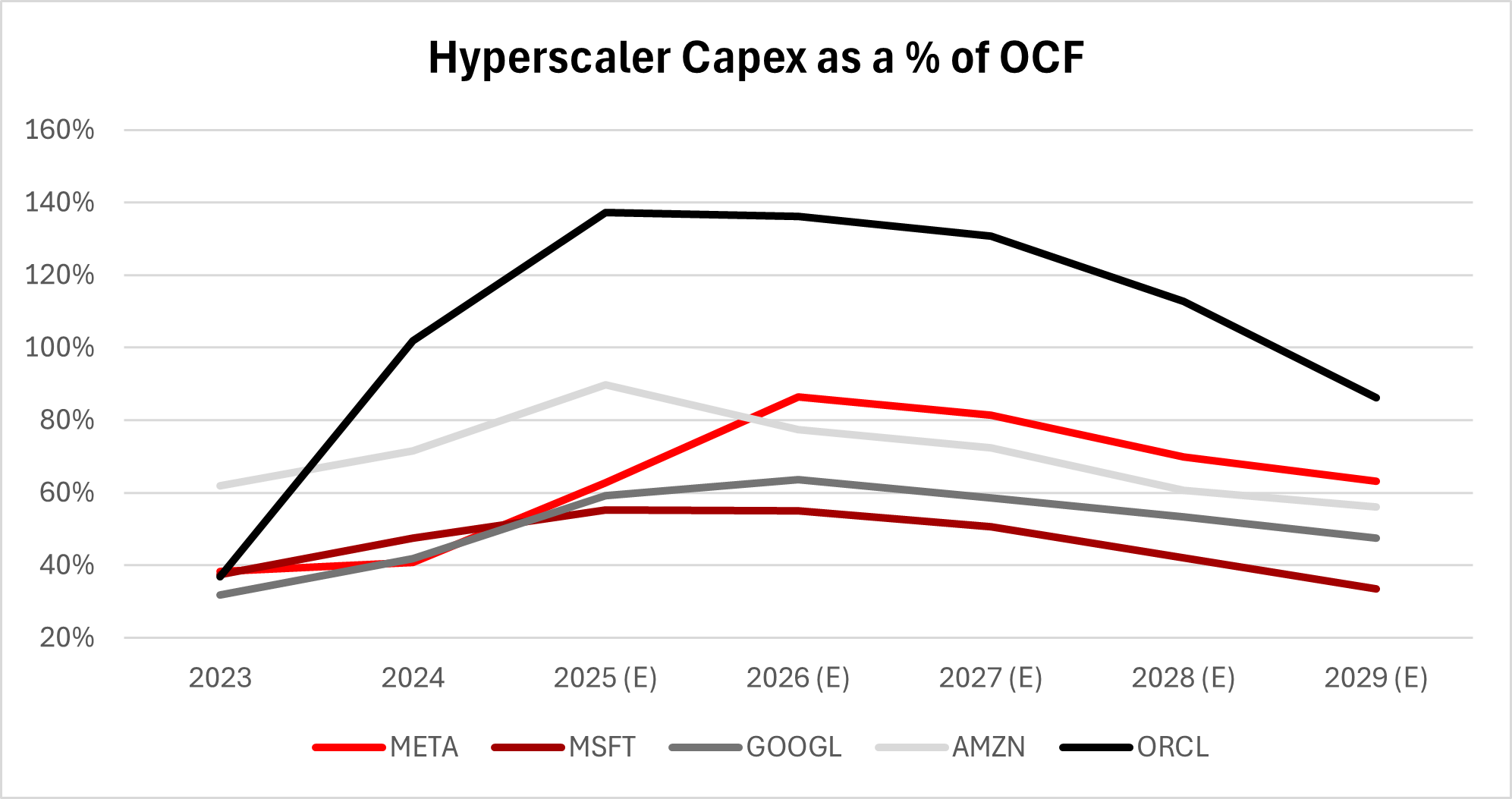Table of Contents
Investment Thesis
We believe the recent correction in Meta’s share price represents a market overreaction to concerns about elevated AI infrastructure spending. While investor skepticism around capital intensity and uncertain monetization paths is understandable, we view the stock’s current discount as excessive given Meta’s enduring cash-flow strength thanks to their family of apps business, and history of monetizing large-scale investment cycles.
We therefore raise our target price to US$896.6 (from US$863), incorporating updated assumptions post-Q3 2025 earnings. The risk-reward remains favorable, even after factoring in near-term margin compression.
Addressing Investor Concerns
1. Capital Intensity and Cash Flow Durability
The current investment cycle is set to meaningfully pressurize Meta's free-cashflow generation, with capex as a percentage of operating cashflows increasing significantly over the past 2 years and expected to begin normalizing only post 2027.

Having said that, the above is true for all the hyperscalers, where the current AI driven capex cycle is likely to contribute towards a short term increase in capex as a percentage of operating cashflow, which should however normalize once the inital heavy lifting has been taken care of.

Broadly, the market is concerned about these AI related investments eating up all of the operating cashflow being generated and translating into a period of negative free cashflow generation / cash burn - as is currently the case with Oracle and multiple neo-cloud players such as Coreweave.
2. Family of Apps (FoA) and Emerging Applications
Investor skepticism over new applications is understandable, particularly given Threads’ perceived lack of traction. However, usage metrics tell a different story: Threads continues to see steady growth in both DAUs and time spent, with monetization now beginning through limited ad rollouts.
Vibes, Meta’s newly launched AI-augmented video generator, enhances short-form content creation and integrates tightly with Reels, improving engagement and advertiser ROI. These initiatives reinforce FoA’s competitive moat and open incremental monetization vectors within the existing user base.
The FoA segment remains Meta’s financial engine—contributing over 98% of operating profit—and is worth significantly more than the company’s current enterprise value, even without assigning material value to Reality Labs or AI initiatives.
3. AI Infrastructure Spend and Monetization Path
Concerns about Meta’s AI capex are valid—2025 CapEx guidance of US$70–72 billion is among the highest in corporate history—but we view the investment as strategic rather than speculative.
Mark Zuckerberg has outlined a clear, three-tiered utilization plan for the new compute capacity:
- Meta Superintelligence Labs (MSL): advancing large-scale foundation models for integration into Meta’s ecosystem.
- Family of Apps: using compute to improve ad targeting and recommendation engines, where early results already show higher ad impression growth and better yield per impression.
- Surplus capacity utilization: management has hinted at potential external leasing of capacity—comparable to emerging “neo-cloud” players such as CoreWeave—but the difference lies in Meta’s ability to pair compute with proprietary AI models and data assets, rather than acting as a generic GPU landlord.
This distinction matters. If Meta’s edge in proprietary models (LLaMA, Mistral partnerships) leads to differentiated offerings, surplus compute can be monetized at a premium yield, enhancing overall ROIC.
4. Competition and Margin Outlook
We acknowledge that competitive intensity among hyperscalers—Microsoft, Google, Amazon—is increasing. All are pursuing overlapping AI infrastructure and model capabilities. However, Meta remains unique in vertical integration: it owns the user platforms, data pipelines, and application layer that immediately benefit from model deployment.
Our model assumes a two-year margin compression phase as AI and talent costs flow through P&L, followed by a gradual recovery toward ~40% operating margin by FY28.
- FoA margins should expand through scale efficiencies, improved ad yields, and AI-driven cost reductions.
- Losses from Reality Labs and MSL should moderate as the investment base matures and selective projects are shuttered.
While competitive pricing may cap incremental margin upside industry-wide, Meta’s sheer scale, engagement data, and advertiser dependence on its platforms provide meaningful buffer against margin erosion.
5. Historical Perspective and Monetization Track Record
It is fair to note that Meta’s last major capex cycle—the Metaverse push—has yet to deliver tangible returns. Reality Labs continues to post large losses, although the recent traction of the Meta AR glasses suggests that early consumer adoption is improving.
However, comparing this to the current AI-driven investment cycle may be misleading. Unlike the Metaverse bet, the AI infrastructure build-out directly supports the FoA business—the company’s core cash generator—by enhancing ad performance and engagement.
Meta’s past cycles (mobile pivot, Reels integration, feed personalization) demonstrate an ability to translate capex into durable revenue growth. The same mechanism is now visible with AI: improved ad conversion rates and engagement metrics point to early payoffs from these infrastructure investments, while continuing to view the investments being made into MSL as a long term call option, albeit an expensive one.
Our positive stance on the stock, irrespective of the concerns highlighted above
- The family of apps segment in isolation, is worth a lot more than what the entire company currently trades for: The FoA business currently generates in excess of $100 billion in operating cashflow and requires limited maintenance capex, predominantly given the nature of business (digital advertising), converting almost all of it into free-cashflow.
Valuing that business in the form of a growing annuity, driven by steady ad impression and pricing growth, plus additional modes of monetization we see the business to be worth close to 2 trillion (4% free-cashflow yield), compared to its current market capitalization of $1.6 trillion.
- Worst case scenario on the AI driven capex front does not negate the family of apps argument made above: Even if we were to assume that the entirety of the capex currently being done reaps absolutely no returns (which is not our base case) - we would expect Meta's management to shelve projects such as Meta superintelligence Labs and associated spending - leaving behind just the family of apps business, which continues to grow in terms of its user base and has no real competition whatsoever and at this point of time, we would expect the stock price of the company to converge with the value that would be assigned to the family of apps business.
- Even at the peak of the capex cycle, Meta is expected to keep capex as a % of operating cashflows to be sub 100% / maintain positive free-cashflow: Based on the current analyst consensus - the next 2 years are likely to be the worst in terms of the capex cycle's intensity. Yet, the expectations for free-cashflow generation remain positive and not so far from what the other hyperscalers are seeing (a segment that the market does not seem to be as concerned about, as compared to Meta).
Risks
- 2022 all over again: The current setup is such that the company is able to finance the entirety of its capex needs from the cash generated by the family of apps segment, but any slowdown in the apps business at this juncture of the capex cycle, will result in capex as a percentage of operating cashflow getting closer / exceeding 100% and therefore translating into cash being burned and we do not expect the market to take this kindly, as we saw back in 2022, when the reality labs segment was burning cash at an increasing rate, but the apps business began slowing down and free-cashflow took a hit.
- Irrational spending, without seeing evidence of monetization / development of something meaningful: Our base case assumes that the management of the company will spend rationally - in essence shelving projects / capex avenues that are not delivering meaningfully and showcasing a clear path towards monetization (even after a sizeable spend). What can have a meaningful impact to our valuation estimate is the management's reluctance to curtail spending even after having adequate evidence of lacking returns on the investment, as has been the case with the reality labs segment.
- Loss of focus on the core apps franchise leading to market share loss: Meta as a company faces next to no threat of a significant left-tail event as long as the company's apps business continues to grow and churn out a meaningful amount of profits / cash every year. Any complacency on the apps front in the form of not providing adequate resources / capital to continue to innovate and maintain the competitive moat will introduce terminal risk - something we do not price in or even expect but remain cognizant of, in the current setup where management focus seems to be spread across multiple directions and being prioritized in favor of meta super-intelligence lab (MSL).
Conclusion
Investor caution toward Meta’s elevated AI spending is warranted, but the extent of the recent sell-off is disproportionate to fundamental risk. The company’s core business continues to compound, cash generation remains exceptional, and management has articulated a credible roadmap for compute monetization.
Meta’s investment phase is best viewed as strategic capacity expansion, not overreach. Historical precedent, free-cash-flow resilience, and valuation discount together create a compelling opportunity.
We reiterate our positive stance on Meta, with a target price of US$896.6, reflecting confidence in post-2027 margin normalization, robust FoA monetization, and upside optionality from AI infrastructure deployment.














.png)
%20(9).webp)
.webp)
